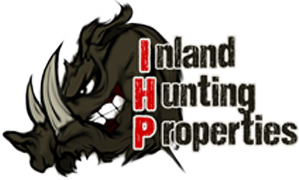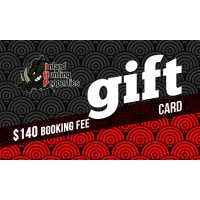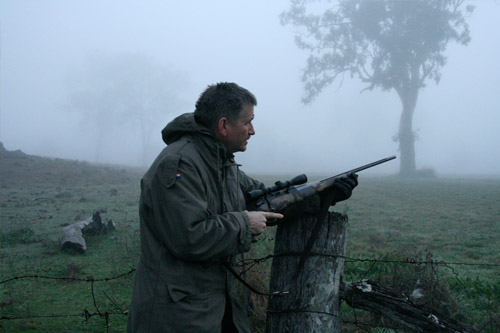
If you are seeking a feed of venison, or a trophy set of antlers, you need to know your aiming points. Don Caswell provide a guide for deer hunters.
Deer are the epitome of a noble, desirable quarry. Stately and elegant, they glide through the bush with grace and style. Deer often choose to live in picturesque terrain, which enhances the pleasure of hunting them.
The stags carry impressive antlers and many hunters have developed a passion with trophy hunting.
Venison is rightly regarded as a prized, high-quality meat. This alone, in my book, makes deer a desirable quarry. At this time, there have probably never been so many deer in Australia.
Populations of deer are growing and spreading into country where they were previously unknown. Most farmers do not begrudge a few deer feeding off their lucerne and oats. However, the charm wears thin when times are tough and there are dozens of deer or more competing for food with the farmer’s livestock.
At times like this, you can be of assistance to the landowners and be amply rewarded with prime-quality meat for your efforts.
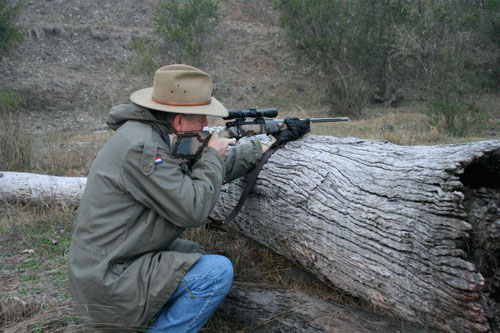
Hunting & Shooting
Once again, it is important to draw the distinction between shooting and hunting.
To me, hunting means stalking through the bush, seeking game, taking your shot from whatever field position the situation allows. Under these conditions, adequate calibres are needed.
Deer in general are rather delicate and do not require particularly heavy calibres. The .243 is a popular and very successful choice worldwide for deer hunting. In the past, during the heydays of deer culling in New Zealand, vast numbers of deer were taken with the .222 Remington.
I know a few very successful deer hunters who have used .223 and .22-250 rifles to great effect over the past few decades. When targeting small deer for prime venison I like to use a single shot stalking rifle in 223 Remington.
However, it has to be stressed that you must be a good stalker and get close. The other essential is good discipline and only take shots you know you can pull off.
An important consideration in recent times is the recognition of deer as valid game species and the introduction of regulations for minimum calibres for different deer species. Typically, there are variations between states, so if you do hunt interstate, it is important that you make yourself aware of these requirements. As familiar and successful as you may be with Old Betsy, your long-time deer rifle, you may need to be thinking about a change of calibre if the laws or regulations command.
Over the years I have found the 7mm calibres to be great all-round performers on deer. Some of my buddies are great fans of the 30 calibres for deer. This is particularly so if you are chasing bigger bodied specimens. Sambar hunting is of course in its own league and the 7mm and thirties are entry level for those big, wild country deer.
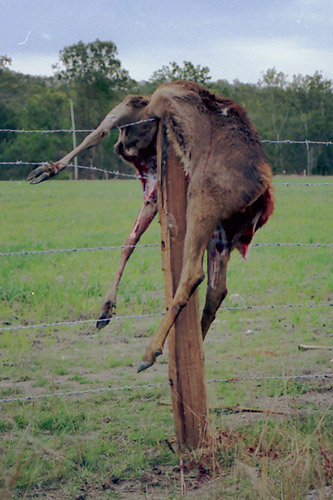
Background Check
For shooting or culling purposes, either from a solid stand or from a vehicle, especially if using a spotlight at night (where legal), then the legal minimum centrefire calibre rifle is okay, as long as the shooter can do their part.
Safety is very important when shooting deer off cultivation and this is another reason to use a lighter calibre.
With deer feeding on open, cultivated paddocks, you need to be very aware of your background, especially if you are going to use a calibre where there is likelihood of a projectile exiting the target animal. Livestock, nearby houses, farm equipment, vehicles travelling on nearby roads and of course, passersby may be at risk in these circumstances. So if you are going to be shooting deer off cultivation, do your homework first. Determine your shooting positions and fields of fire before the event. If potential hazards limit your options for taking deer on the cultivation, another option is to ambush them at their point of access.
Deer, when entering to feed on crops, are pretty predictable, and will generally have a set path they follow to reach the paddock in question. Typically, this will be up from a bordering creek bed or down from a gully that runs up into a timbered ridge. Take the time to walk around the paddock. If it is not obvious from tracks, deer pellets and hair caught in fence wire where the deer are accessing the paddock, then the landowner should be able to point you in the right direction.
Whether you are targeting deer in the middle of an oats patch or bushwhacking them on their way, you need to ensure safe background conditions. Ideally, you want a hill, gully-side or heavy timber behind the animal you will be shooting. Failing that, you need to be confident that there are kilometres of unpopulated wilderness in the zone behind your quarry.
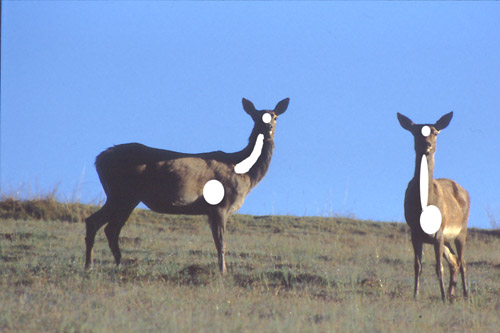
Aiming Points
When culling deer off cultivation, we normally seek head and neck shots. This presumes that we have a solid, stable shooting position and are limiting ourselves to a maximum range of 150m. If a longer shot is needed, or we are obliged to move location and have a less stable shooting position, we would take a chest shot.
In hunting circumstances, safe background conditions are generally more easily met. Deer stalking is usually done in heavily timbered ridge and gully country. Adequate calibres are preferred because of more difficult field-shooting conditions, intervening bush and uncertain distances. Obviously, there is nothing special about those particular calibres and anything from the minimum calibre on upwards, that you can shoot well with, will be fine.
In deer stalking-style hunting, we normally restrict ourselves to chest shots. Occasionally, in field conditions, you will get the opportunity of a close-range shot at undisturbed game. Sometimes, in these circumstances, a neck shot is a viable option. Normally, we would not be tempted to take a head shot under hunting conditions.
In culling situations, where you may be dropping as many as a dozen or more deer in a sitting, head and neck shots deliver instant kills. The animal just folds up and flops to the ground, without unduly disturbing the rest of the nearby mob. Most times too, with head and neck shots, there is good bleeding, which enhances the subsequent meat quality. Our goal is always to harvest as much meat as possible.
As you can see from the accompanying illustrations, the neck and head target zones are quite small. The chest shot is much bigger by comparison and a better choice under hunting conditions. A well-placed chest shot is very effective and need not damage too much meat.
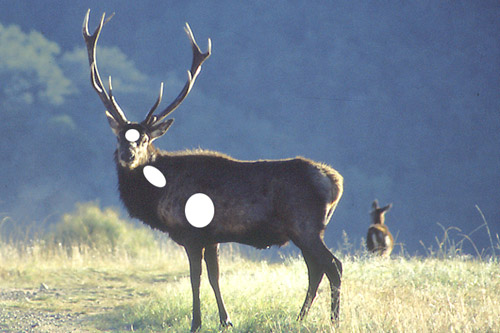
Projectiles
Choice of projectile is most important. There are a wide range of premium projectiles that have been developed specifically for hunting deer in both the USA and Europe.
With the smaller calibres it makes sense to check and ensure that it is a game projectile and not one intended for varminting. When taking chest shots on deer the ideal projectile is one that expands rapidly to a wide diameter (for shock) but which retains all or most of its original weight (for penetration).
Varminting projectiles can be unreliable if they hit bone because they are designed to shed most of their weight in a rapid, explosive expansion and will deliver a non-fatal surface wound on game animals, which is the last thing anyone wants. A well constructed game bullet will punch through the shoulder bone, and any ribs in its way, cause catastrophic damage to the heart and arteries along with massive shock to the animal for a quick and numbing death.
I consider the perfect shot is one just above the point of the shoulder, which just misses that bone structure, takes out a rib, then the heart and arteries before breaking the off-side shoulder and pulling up just under the skin on the far side.
Such a shot demonstrates to me, besides correct placement, the ideal balance of bullet construction, weight and calibre with delivered velocity.
Obviously, you can’t guarantee that sort of performance with every shot, but when you have found your hunting load and are shooting similar sized animals, you may be surprised at how repeatable it is.
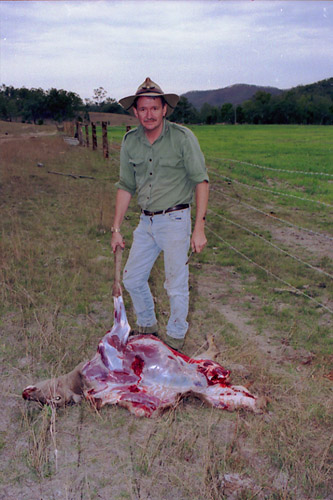
Exit Okay
There is nothing wrong with exit wounds. In fact, if I took a side on shot at a deer which took out a rib or two and the coronary area, but managed to miss both sets of shoulder bones, I would want to see an exit wound.
Otherwise I would consider that particular load under-powered and would be looking for something with more penetration. Obviously, you can’t always expect your quarry to pose nicely side on for you.
Your choice of calibre and loading has to contend with the likelihood that the target animal may be angled either toward or away from the shooter. I generally avoid quartering away shots on game animals and will wait for a better angle to present itself before taking the shot.
With an animal angled toward the shooter, there may be no option but to punch through the on-side shoulder and maybe a parcel of ribs too. That is why premium game projectiles are required.
It is to ensure ideal performance and outcome when the target animal presents a less than perfect stance to the hunter. Luckily there is a great selection of factory ammunition loadings with premium game projectiles for most popular calibres. Handloaders naturally have even greater options.
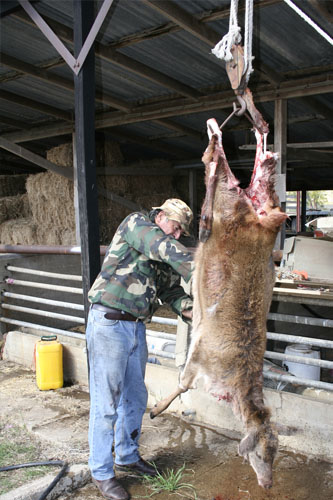
Practice Makes Perfect
To maximise your chances of success it pays to practice. That definitely includes some range work and field shooting too. I normally only use one particular loading in any rifle, once I have found one that shoots accurately and performs to my expectations.
This is because of differences in point of impact between loads. You may be lucky though. I have buddies who have rifles that shoot a variety of projectile weights to exactly the same point over hunting distances.
Still and all, I prefer to get my game load sorted and then I use that for everything. Shooting various small feral pests with your game load will ensure that you are more than familiar with functionality of your rifle and in its field use.
That familiarity, combined with good shot placement will put venison on the table.
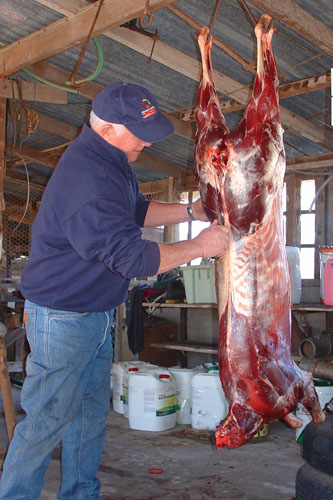
© Don Caswell 2010
This story was published by the SSAA in Hunter 48 - April 2014.
About the author
Since 1981 Don Caswell has been a freelance writer, photographer & illustrator. Don is the author of hunting stories and the provider of technical shooting information. Don an independent reviewer of hunting, shooting & outdoors products, in addition to being a blogger & webmaster with Facebook & Instagram presence. Don is also a senior writer for the Sporting Shooters Association of Australia (SSAA) and his articles appear regularly in their publications. This article was originally published in the SSAA in April 2014.
Visit Don Caswell's Aussie Hunter Website here
